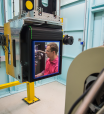Success of Australian Synchrotron Open Day reflects public interest in science
Close to 3000 members of the public decided to have a look at a building that is shaped like a doughnut, is as big as a football field and creates light more powerful than the sun when the Australian Synchrotron held its bi-annual Open Day held on Sunday, 16 October.





